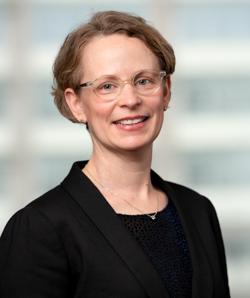Swetland Professor of Environmental Health Sciences, Department of Population and Quantitative Health Sciences, School of Medicine
Director, Mary Ann Swetland Center for Environmental Health, School of Medicine
Darcy Freedman is an applied population health scientist and community psychologist who is nationally recognized for her contributions to community nutrition. Among her roles at Case Western Reserve, Freedman directs the Nourishing Power Network at the Swetland Center for Environmental Health. The Nourishing Power Network is part of a research study that is testing ways to transform food systems by bridging community power with organizational power to spark and expand food justice initiatives led by the community. Read more about Freedman.
You have a BA in Zoology, an MPH and a PhD in Community Research and Action. Can you talk about your career pathway? What were the formative experiences along the way?
I started off as a pre-med student with my zoology degree but realized that I wanted some life experience before going to medical school. So I joined Teach For America, where I taught seventh grade life science in Baton Rouge, Louisiana. This experience exposed me to many public health challenges, such as students who missed 30-plus days of school due to lack of access to asthma treatments. I switched paths from medicine to public health, where I became increasingly interested in community-level influences shaping health behaviors. After working at the Centers for Disease Control and Prevention for a few years, I decided to get a PhD in Community Research and Action to further my training in community-engaged research on structural influences shaping community health.
How did you become interested in food systems? Over the years, what's been your biggest learning from when you first began this work?
I started my food systems work because of a deep commitment to community-engaged research. I wanted to study things that mattered to the community. Even though my prior research experiences were related to HIV/AIDS prevention, food was a topic that came up time and time again in community conversations. These conversations exposed me to the nuances of food (in)access that were not prioritized within public health discourse at the time—this was in the early 2000s. My first project related to food access involved starting a youth-run farmers’ market in a public housing community in Nashville. The market was founded as a response to community concerns about lack of access to a grocery store. This experience also seeded my involvement in establishing a food security coalition because it was clear many people needed to come to a common table to grow food justice. Nearly 20 years later, I am amazed that food access continues to be a theme uniting communities working for health equity.
Tell us about the genesis of FM Tracks. How did that come to be and what spurred development of the app?
My research on food access continued to point to the need to address both physical and economic barriers to access. One customer at a farmers’ market involved with my dissertation research summed it up beautifully when he said: “I know the peaches are worth the price, but I just don’t have the money to buy them.” This spurred my research focused on financial incentives to reduce the cost of fruits and vegetables. As this research—along with other studies from collaborators across the country—turned into evidence demonstrating the effectiveness of these incentives on dietary behaviors, it was clear that technology could be used to streamline implementation on nutrition incentive programs. In 2014, the U.S. Farm Bill funded the first-ever federally funded incentive programs for farmers’ markets. I developed FM Tracks because of concerns that nutrition incentives would not be implemented in areas that may need them the most because of concerns related to tracking and evaluation of monetary incentives. We launched FM Tracks in 2015 and currently have over 500 FM Tracks users in about 20 states.
What do you like most about being a part of the CWRU community?
I love the people! I’m lucky to work directly with an amazing team at the Swetland Center for Environmental Health and in the Department of Population and Quantitative Health Sciences, which is my primary department. I also get to work with colleagues from across campus through partnerships related to population and community health. In the past few years, I’ve benefited greatly from the role Case Western Reserve plays as a convener of partners from across the city and region. I find CWRU folks to be open to opportunities and willing to listen and explore new ways of thinking and doing.
How do you like to spend your free time?
I’m happiest when I’m outside whether watching my boys at a sporting event or drinking coffee on a patio or walking around the Shaker Lakes or a Metro Park. I love the four seasons in Cleveland, though summer and fall in Cleveland are my favorite times to be outside!


